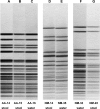Distribution of virulence factors and molecular fingerprinting of Aeromonas species isolates from water and clinical samples: suggestive evidence of water-to-human transmission
- PMID: 20154106
- PMCID: PMC2849238
- DOI: 10.1128/AEM.02535-09
Distribution of virulence factors and molecular fingerprinting of Aeromonas species isolates from water and clinical samples: suggestive evidence of water-to-human transmission
Abstract
A total of 227 isolates of Aeromonas obtained from different geographical locations in the United States and different parts of the world, including 28 reference strains, were analyzed to determine the presence of various virulence factors. These isolates were also fingerprinted using biochemical identification and pulse-field gel electrophoresis (PFGE). Of these 227 isolates, 199 that were collected from water and clinical samples belonged to three major groups or complexes, namely, the A. hydrophila group, the A. caviae-A. media group, and the A. veronii-A. sobria group, based on biochemical profiles, and they had various pulsotypes. When virulence factor activities were examined, Aeromonas isolates obtained from clinical sources had higher cytotoxic activities than isolates obtained from water sources for all three Aeromonas species groups. Likewise, the production of quorum-sensing signaling molecules, such as N-acyl homoserine lactone, was greater in clinical isolates than in isolates from water for the A. caviae-A. media and A. hydrophila groups. Based on colony blot DNA hybridization, the heat-labile cytotonic enterotoxin gene and the DNA adenosine methyltransferase gene were more prevalent in clinical isolates than in water isolates for all three Aeromonas groups. Using colony blot DNA hybridization and PFGE, we obtained three sets of water and clinical isolates that had the same virulence signature and had indistinguishable PFGE patterns. In addition, all of these isolates belonged to the A. caviae-A. media group. The findings of the present study provide the first suggestive evidence of successful colonization and infection by particular strains of certain Aeromonas species after transmission from water to humans.
Figures



References
-
- Abdullah, A. I., C. A. Hart, and C. Winstanley. 2003. Molecular characterization and distribution of virulence-associated genes amongst Aeromonas isolates from Libya. J. Appl. Microbiol. 95:1001-1007. - PubMed
-
- Abuhammour, W., R. A. Hasan, and D. Rogers. 2006. Necrotizing fasciitis caused by Aeromonas hydrophila in an immunocompetent child. Pediatr. Emerg. Care 22:48-51. - PubMed
-
- Aguilera-Arreola, M. G., C. Hernandez-Rodriguez, G. Zuniga, M. J. Figueras, and G. Castro-Escarpulli. 2005. Aeromonas hydrophila clinical and environmental ecotypes as revealed by genetic diversity and virulence genes. FEMS Microbiol. Lett. 242:231-240. - PubMed
-
- Albert, M. J., M. Ansaruzzaman, K. A. Talukder, A. K. Chopra, I. Kuhn, M. Rahman, A. S. Faruque, M. S. Islam, R. B. Sack, and R. Mollby. 2000. Prevalence of enterotoxin genes in Aeromonas spp. isolated from children with diarrhea, healthy controls, and the environment. J. Clin. Microbiol. 38:3785-3790. - PMC - PubMed
Publication types
MeSH terms
Substances
Grants and funding
LinkOut - more resources
Full Text Sources

